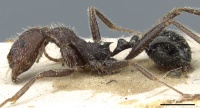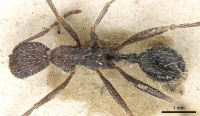Aphaenogaster campana
| Aphaenogaster campana | |
|---|---|

| |
| Scientific classification | |
| Kingdom: | Animalia |
| Phylum: | Arthropoda |
| Class: | Insecta |
| Order: | Hymenoptera |
| Family: | Formicidae |
| Subfamily: | Myrmicinae |
| Tribe: | Attini |
| Genus: | Aphaenogaster |
| Species group: | testaceopilosa |
| Species: | A. campana |
| Binomial name | |
| Aphaenogaster campana Emery, 1878 | |
Nothing is known about the biology of Aphaenogaster campana.
Identification
A member of the A. testaceopilosa group. Boer (2013) - The workers, gynes, and especially the males are rather easy to distinguish from the other species (see keys), and only because of their shiny parts they could be misidentified as Aphaenogaster semipolita (see worker key).
Keys including this Species
- Key to Aphaenogaster European testaceopilosa-group workers
- Key to Aphaenogaster European testaceopilosa-group queens
- Key to Aphaenogaster European testaceopilosa-group males
Distribution
Latitudinal Distribution Pattern
Latitudinal Range: 41° to 39°.
| North Temperate |
North Subtropical |
Tropical | South Subtropical |
South Temperate |
- Source: AntMaps
Distribution based on Regional Taxon Lists
Palaearctic Region: Albania, Italy (type locality), Malta.
Distribution based on AntMaps
Distribution based on AntWeb specimens
Check data from AntWeb
Countries Occupied
| Number of countries occupied by this species based on AntWiki Regional Taxon Lists. In general, fewer countries occupied indicates a narrower range, while more countries indicates a more widespread species. |

|
Estimated Abundance
| Relative abundance based on number of AntMaps records per species (this species within the purple bar). Fewer records (to the left) indicates a less abundant/encountered species while more records (to the right) indicates more abundant/encountered species. |

|
Biology
Castes
Nomenclature
The following information is derived from Barry Bolton's Online Catalogue of the Ants of the World.
- campana. Aphaenogaster testaceopilosa var. campana Emery, 1878b: 54 (footnote), fig. (w.q.m.) ITALY.
- Type-material: syntype workers, syntype queens, syntype males (numbers not stated).
- [Note: Boer, 2013: 71, cites 5w, 2q, 4m syntypes MSNG.]
- Type-localities: Italy: Campania, Portici, vii.1868, and ix.1868 (C. Emery), Italy: Campania, “aquifers of Vesuvius” (C. Emery).
- Type-depository: MSNG.
- Subspecies of testaceopilosa: Emery & Forel, 1879: 463; André, 1883b: 361; Emery, in Dalla Torre, 1893: 107 (footnote); Emery, 1908c: 322; Emery, 1916b: 131; Emery, 1921f: 62; Ceballos, 1956: 299.
- Status as species: Dalla Torre, 1893: 100; Santschi, 1933c: 400 (redescription); Santschi, 1934d: 273; Baroni Urbani, 1968b: 426; Baroni Urbani, 1971c: 40; Schembri & Collingwood, 1981: 425; Agosti & Collingwood, 1987b: 269 (in key); Bolton, 1995b: 68; Poldi, et al. 1995: 3; Petrov, 2006: 90 (in key); Boer, 2013: 71 (redescription); Borowiec, L. 2014: 9; Lebas, et al. 2016: 250.
- Distribution: Albania, Italy.
Unless otherwise noted the text for the remainder of this section is reported from the publication that includes the original description.
Description
Worker
Boer (2013) - Lateral sides of mesosoma with distinct longitudinal rugulae. Rugulose sculpture on the dorsal side coarse. Most of the workers with longitudinal rugae on posterior part of propodeum. Head in full-face view with longitudinal rugulae with cross-connections. Clypeus of nearly all workers with transverse, U-shaped rugulae. Terminal side of propodeum, beneath the propodeal spines nearly smooth, sometimes transversely costulate. Dorsal half of lateral sides of petiole and postpetiole with or without punctation. Dorsal side of petiolar nodes punctate. Dorsal side of postpetiole with longitudinal costulae that continue into microstriae on first gastral tergite. Posterior half of gaster often smooth. Pronotum nearly glossy. Dorsal side of the gaster glossy satin. Head and mesosoma nearly matt. Dorsal half of lateral sides of petiole and postpetiole wax glossy. Dorsal side of petiolar nodes, terminal side of propodeum, beneath the propodeal spines and lateral sides of gaster glossy to shiny. Petiole equal in height to postpetiole or somewhat higher. Antennal club 4-segmented. Propodeum in lateral view generally slightly bulging. Setosity on propodeum longer than on other parts.
Measurements (n = 29). CI 69–80 (76); CL 1.16–1.57 (1.36) mm; CW 0.84–1.24 (1.03) mm; PHI 27–36 (32); PI 67–96 (81); PPPI 48–58 (51); PSI 144–200 (168); PSLWI 89–136 (114); PWI 20–35 (23); RPH 113–150 (133); RPSI 33–64 (46); SI 136–151 (144); SI/CI 173–230 (191); SL 1.32–1.70 (1.48) mm; SPD 1–3 (2.2); SPL 1–5 (1.7)
Queen
Boer (2013) - Longitudinal rugulae on head, scutellum, anterior side of postpetiole and on some parts of mesoscutum. Transverse rugulae on clypeus, pronotum, propodeum, posterior side of petioles and on some parts of mesoscutum. Punctation distinct on head, weakly pronounced on mesosoma and petioles. Less than ten transverse microstriae near base of first gastral tergite. Anterior side of the petiole smooth. Mesosoma dorsally matt glossy, gaster dorsally satin. Mesosoma and dorsal side of petioles glossy. Antennal club 4-segmented. Scape weakly or not at all rugulose. Scutellum rises slightly above the mesoscutum and bends over the metanotum.
Measurements (n = 3). CI 86–91; CL 1.70–1.77 mm; CW: 1.52–1.55 mm; OCI: 27–30 (28); PHI 129–132; PI 70–79; PPPI 63–69; PSI 213–233; PSLWI: 100–118; PWI 28–33; RPH: 36–37; RPSI 63–93; SI 106–110; SI/CI 116–124; SL 1.64–1.68 mm; SPL 1–4.
Male
Boer (2013) - Rugulae only on lateral parts of the propodeum. Punctation on head, lateral sides of the mesosoma, petioles and on clypeus very weak. Dorsal side of propodeum, petioles and dorsal side of gaster very weakly microreticulated, nearly smooth. Head, clypeus and mesoscutum softly glossy, dorsal side of gaster wax glossy. Dorsal side of propodeum, lateral sides of mesosoma and gaster shiny. Antennal club 5-segmented. Pubescence on hind tibia suberect to erect, their length longer than the diameter of the tibia. Mesoscutum strongly elevated (more than in other species). (Scutellum lower than mesoscutum, bent over metanotum. Head without frontal midline. No groove at posterior side of the propodeum, terminal end rounded. Propodeum wider than metasternum and bulging, saddle-shaped.
Measurements (n = 6). CI 94–102 (97); CL 0.70–0.78 (0.74) mm; CW 0.67–0.75 (0.72) mm; EYI 41–47 (43); OCI 40–45 (42); SL/CL 40–43 (41); SL 0.30–0.31 (0.31) mm.
References
- Baroni Urbani, C. 1971c. Catalogo delle specie di Formicidae d'Italia (Studi sulla mirmecofauna d'Italia X). Memorie della Societa Entomologica Italiana 50: 5-287 (page 40, raised to species)
- Boer, P. 2013. Revision of the European ants of the Aphaenogaster testaceopilosa-group (Hymenoptera: Formicidae). Tijdschrift voor Entomologie 156, 57–93.
- Borowiec, L. 2014. Catalogue of ants of Europe, the Mediterranean Basin and adjacent regions (Hymenoptera: Formicidae). Genus (Wroclaw) 25(1-2): 1-340.
- Dalla Torre, K. W. von. 1893. Catalogus Hymenopterorum hucusque descriptorum systematicus et synonymicus. Vol. 7. Formicidae (Heterogyna). Leipzig: W. Engelmann, 289 pp. (page 100, raised to species)
- Emery, C. 1878c. Catalogo delle formiche esistenti nelle collezioni del Museo Civico di Genova. Parte seconda. Formiche dell'Europa e delle regioni limitrofe in Africa e in Asia. [concl.]. Ann. Mus. Civ. Stor. Nat. 12: 49-59 (page 54, fig. worker, queen, male described)
- Emery, C. 1908d. Beiträge zur Monographie der Formiciden des paläarktischen Faunengebietes. (Hym.) (Fortsetzung.) III. Die mit Aphaenogaster verwandte Gattungengruppe. Dtsch. Entomol. Z. 1908: 305-338 (page 322, retained as subspecies)
- Emery, C. 1916a [1915]. Fauna entomologica italiana. I. Hymenoptera.-Formicidae. Bull. Soc. Entomol. Ital. 47: 79-275 (page 131, retained as subspecies)
- Emery, C. 1921c. Hymenoptera. Fam. Formicidae. Subfam. Myrmicinae. [part]. Genera Insectorum 174A:1-94 94: 1-94 + 7 (page 62, retained as subspecies)
- Santschi, F. 1933d. Étude sur le sous-genre Aphaenogaster Mayr. Rev. Suisse Zool. 40: 389-408 (page 400, raised to species)
- Schifani, E., Alicata, A., Menchetti, M., Borowiec, L., Fisher, B.L., Karaman, C., Kiran, K., Oueslati, W., Salata, S., Blatrix, R. 2022. Revisiting the morphological species groups of West-Palearctic Aphaenogaster ants (Hymenoptera: Formicidae) under a phylogenetic perspective: toward an evolutionary classification. Arthropod Systematics & Phylogeny 80, 627–648 (doi:10.3897/asp.80.e84428).
References based on Global Ant Biodiversity Informatics
- André, E. "Species des Hyménoptères d'Europe et d'Algérie. Les fourmis." in: André, Edm. 1881-1886. Species des Hyménoptères d'Europe et d'Algérie. Tome Deuxième. Beaune: Edmond André, 919 + 48 pp. Tomo II (1881): 1016.
- Baroni Urbani C. 1968. Studi sulla mirmecofauna d'Italia. IV. La fauna mirmecologica delle isole Maltesi ed il suo significato ecologico e biogeografico. Ann. Mus. Civ. Stor. Nat. Giacomo Doria 77: 408-559.
- Boer P. 2013. Revision of the European ants of the Aphaenogaster testaceopilosa-group (Hymenoptera: Formicidae). Tijdschrift voor Entomologie 156: 57-93.
- Borowiec L. 2014. Catalogue of ants of Europe, the Mediterranean Basin and adjacent regions (Hymenoptera: Formicidae). Genus (Wroclaw) 25(1-2): 1-340.
- Cagniant H., and A. Ledoux. 1974. Nouvelle description d'Aphaenogaster senilis sur des exemplaires de la région de Banyuls-sur-Mer (P.-O.), France. Vie et Milieu. Série C. Biologie Terrestre 24: 97-110.
- Emery C. 1916. Fauna entomologica italiana. I. Hymenoptera.-Formicidae. Bullettino della Società Entomologica Italiana 47: 79-275.
- Emery, C., and A. Forel. "Catalogue des Formicides d'Europe." Mitteilungen der Schweirzerischen Entomologischen Gesellschaft 5 (1879): 441-481.
- Emery, C. "Catalogo delle formiche esistenti nelle collezioni del Museo Civico di Genova. Parte seconda. Formiche dell'Europa e delle regioni limitrofe in Africa e in Asia." Annali del Museo Civico di Storia Naturale 12 (1878): 43-59.
- Gomez K. 2017. Two species of exotic ants (Hymenoptera: Formicidae) new to Malta. Boletin de la Sociedad Entomologica Aragonesa (S.E.A.) 61: 233-235.
- Santschi, F. "Étude sur le sous-genre Aphaenogaster Mayr." Revue Suisse de Zoologie 40 (1933): 389-408.
- Schembri, Stephen P. and Cedric A. Collingwood. A Revision of the Myrmecofauna of the Maltese Islands. 417-442.

